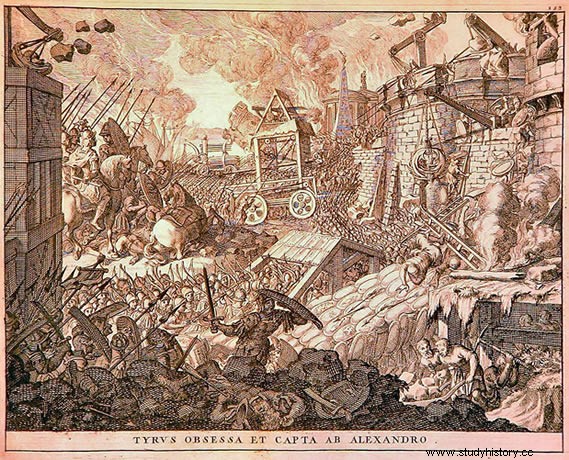One of the greatest conquerors and strategists in history was Alexander the Great, but to take Tiro he had to put a lot of imagination into it. The city of Tyre, located in present-day Lebanon, was one of the largest Phoenician city-states -about 40,000 inhabitants-, with the peculiarity that it had a fortified island in front of it with walls over 40 meters high and two natural harbours.
In 332 BC, Alexander took the part of the city located on the mainland, but he could not do the same with the insular part as he did not have a sufficient fleet to attack it. Given the impossibility of doing it by sea, he decided to do it by land... but it was an island . He ordered the construction of a stone and earth jetty to join the mainland with the island to cover the 700 meters that separated them. When the engineering work began, from the mainland it was much easier because of the shallow depth and the distance from the enemy walls, but when the jetty began to take shape, the depth increased sharply and, furthermore, the enemies were already within reach. the Macedonians. To protect the workers, two towers were built in the most advanced part of the breakwater from which the Tyrians would be constantly harassed. These, who had a solution for each idea of Alejandro, loaded an old ship with all kinds of flammable materials and launched it as a fire ship against the towers to later, with arrows, set fire to the ship and the towers. Faced with that loss and when they had no more solutions, a fleet of more than 200 ships showed up to besiege Tyre. Now Alexander's fleet could protect the construction of the breakwater, even so the ingenuity of the Tyrians was delaying the work.

Six months later, the breakwater was finished and the siege weapons, located on the artificial isthmus, managed to get closer to attack the walls. At the same time, and after having blocked the Tyrian fleet, they also attacked from the sea. When the walls collapsed, the city quickly fell. Although Alexander admired the Tyrians' bravery and ingenuity, he was to punish them as a warning to other cities. Compared to the 8,000 Tyrians killed and the 30,000 sold into slavery, Alexander only lost 400 men.
Image:Lives of Fire
